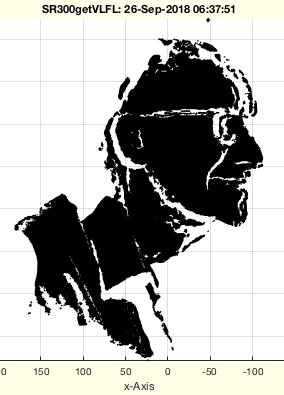SR300getVLFL
by Tim C. Lueth, SG-Lib Toolbox: SolidGeometry 5.6 - RealSense Camera
Introduced first in SolidGeometry 4.3, Creation date: 2018-09-26, Last change: 2025-09-14
returns a surface from the surface camera
See Also: SR300install
, SR300stop
, SR300start
, SR300depthimage
, SR300videoimage
, SR300allimages
, SR300getVL
Example Illustration

Syntax
SG=SR300getVLFL([zl])
Input Parameter
zl: | | zlimitation; default is 400 |
Output Parameter
SG: | | Struct with vertices VL and Facets FL |
Examples
SR300getVLFL; SG=ans;
SGfigure; SGplot(SG); view(-180,-90);
Copyright 2018-2025 Tim C. Lueth. All rights reserved. The code is the property of Tim C. Lueth and may not be redistributed or modified without explicit written permission. This software may be used free of charge for academic research and teaching purposes only. Commercial use, redistribution, modification, or reverse engineering is strictly prohibited. Access to source code is restricted and granted only under specific agreements. For licensing inquiries or commercial use, please contact: Tim C. Lueth
Algorithm (Workflow)
This function, SR300getVLFL, is designed to retrieve a surface from a surface camera, specifically the SR300 model. It is part of the SolidGeometry library and was introduced in version 4.3. The function processes input parameters and returns a structured output.
Input Parameters
- zl: This parameter represents the z-limitation. It is optional and defaults to 400 if not provided. It can be specified by the user to adjust the depth limitation of the surface capture.
Output Results
- SG: This is a structure containing two main components:
- VL: Vertices List, which represents the points captured by the camera.
- FL: Facets List, which represents the connections between the vertices to form a surface.
Algorithm Steps
- Initialize the z-limitation (
zl) to 1000.
- Check if there are any input arguments. If the first argument is provided and not empty, set
zl to this value.
- Call the function
SR300getVL with zl to retrieve the vertices list (VL).
- Generate the facets list (
FL) using the function FLofVLdelaunay with the vertices list as input.
- Create a structure
SG with fields VL and FL.
- If no output is expected (i.e.,
nargout==0), visualize the structure:
- Call
SGfigure to prepare the figure for plotting.
- Use
SGplot to plot the structure SG.
- Set the view angle to (-180, -90) for visualization.
Algorithm explaination created using ChatGPT on 2025-08-18 23:31. (Please note: No guarantee for the correctness of this explanation)
Last html export of this page out of FM database by TL: 2025-09-21